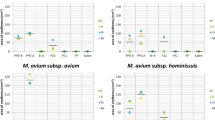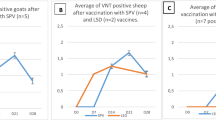Abstract
DURING the course of investigations on the production of immunity to foot-and-mouth disease the intracutaneous route of vaccination has been considered. It has generally been recognized that one disadvantage of this route in large animals is that, owing to the pressure required, only a small volume of inoculum can be injected at one site. Various attempts have been made in the past to overcome this difficulty, and by means of compressed air Curasson, Dischamps and Andryesky1 found it practicable to inject 10 c.c. of their rinderpest vaccine into the skin of the bovine scrotum and vulva.
This is a preview of subscription content, access via your institution
Access options
Subscribe to this journal
Receive 51 print issues and online access
$199.00 per year
only $3.90 per issue
Buy this article
- Purchase on Springer Link
- Instant access to full article PDF
Prices may be subject to local taxes which are calculated during checkout
Similar content being viewed by others
References
Curasson, G., Dischamps, A., and Andryesky, P., Bull. Acad. vét. Fr., 2, 383 (1929).
Author information
Authors and Affiliations
Rights and permissions
About this article
Cite this article
HENDERSON, W. Intracutaneous Injection of Cattle. Nature 152, 629–630 (1943). https://doi.org/10.1038/152629b0
Issue Date:
DOI: https://doi.org/10.1038/152629b0
Comments
By submitting a comment you agree to abide by our Terms and Community Guidelines. If you find something abusive or that does not comply with our terms or guidelines please flag it as inappropriate.



